I received an inquiry from Jan Barrett, “Someone was recently asking me how I knew I was related to John 13 [John of Kingstown], since we obviously don’t have the DNA of an ancestor from hundreds of years ago. I found that I could not explain this! Could you give me a simple explanation of how we can trace our ancestry back to specific Sheldons using DNA?”
I jumped at the opportunity to make this into a teachable moment. Simply stated we have the YDNA of 14 descendants of John SHELDON of Kingstown, RI through various SHELDON male lines of descent and with minor differences their YDNA STR markers match– so we can make a strong assumption that the YDNA they all inherited was through John of Kingstown who was likely the son of Isaac of Windsor, CT [More on that shortly].
Her follow-up question: Does this mean that you have had 14 living male SHELDONs submit their YDNA to the project and you have found similarities in their results? YES, as you can see under the green B2 results below, there are 14 male SHELDON testers from John and they all match each other. [They also match a dozen descendants of Isaac of Windsor Group B1. That’s a total of 26 that all match each other]. They do not closely match any of the other 2 million FTDNA testers as closely as they match each other and they create one of 50,000 Y-DNA branches in the human Y-DNA tree.
With minor deviations over time, a man passes his YDNA from father to son, son to grandson and grandson to great grandson and so forth. So, John of Kingstown’s YDNA is essentially the same as any of his strict patrilineal male descendants or ancestors. The only difference will be a different YSTRS value at a marker or two and occasionally a YSNP (mutation) that will further identify a branch in which it occurred. [YDNA does not go through the process of recombination like autosomal DNA.] Please see my DNA terminology for definitions.
Let’s look at a screen shot of the SHELDON project YDNA results. The first two groups are descendants of Godfrey of Bakewell and a Bakewell SHELDON descendant still living in England. The second two green groups are the descendants of Isaac SHELDON of Windsor CT [Group B1 ]and John of Kingstown RI [Group B2]. If you look at the string of values you will see the orange group have similar values as the green groups for the first 4 markers but at markers 5-6 things diverge broadly. Moreover note in the 5th column, the E-M35 of the orange group vs R-M269 of the green group. The Letters E and R refer to the major Y-DNA Haplogroups. Any two people in two different Haplogroups (even with similar markers) cannot be related in a reasonable amount of time—and most likely 5-10,000 years ago or more. So we know that Group A and Group B are not related in a genealogical time frame.
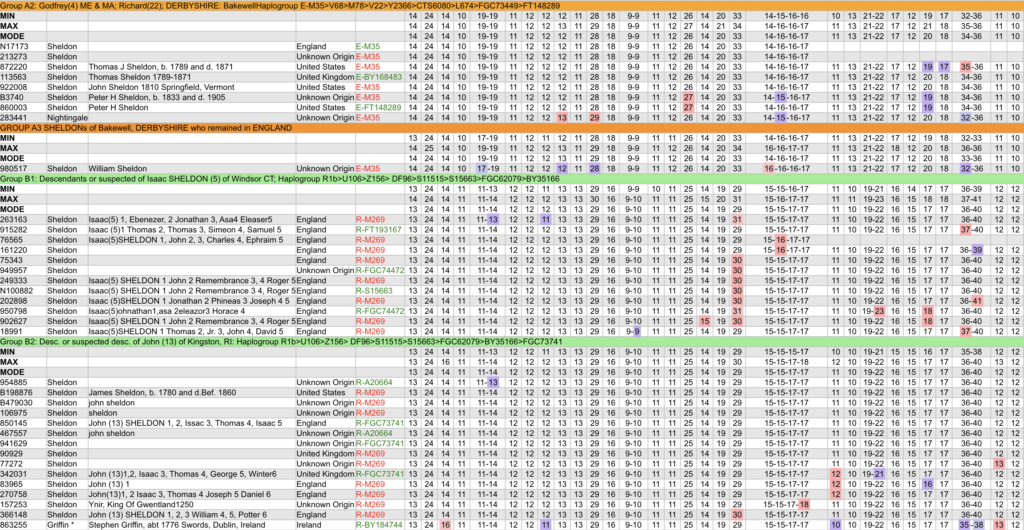
From the FTDNA SHELDON project.
The number after the E is the name of the marker: ie. M35. Markers are named with a letter(s) for the lab and a chronologically assigned number based on when the marker was discovered. The Haplogroup markers (YSNPS) are different from the Y STRS markers which make the many columns we see above. The Broad Haplogroups are based on a mutation that typically happens just once in the history of mankind and all men carrying that marker will have a common ancestor. In the case of the marker M35 (Haplogroup E) the common ancestor is 15,000- 20,500 years ago. For Haplogroup R M269 the common ancestor is 4,000-10,000 years ago. So Haplogroup E is much more ancient than Haplogroup R. The oldest Haplogroup is A and the letters are assigned in alphabetical order. The other values seen after the E or R are markers and those listed in green have been tested usually through a Big Y test, those in red are predicted.
Here is an annotated Beta time tree of Group B:
I have put a red box around the date 1000 Current age (aka as AD). We have a match with a descendant of a GRIFFIN whose common ancestor with Group B is about 1,000 years ago. You can see the defining marker for Group B is BY35166 about the year 1500. Then we have a branching in descendants of John of Kingstown and Isaac Jr of Windsor about 1600-1650. Having the marker A20644 is definitive for a John 13 descendant. Having the marker FGC74472 is definitive for an Isaac Jr descendant. So if you are a male SHELDON and test positive for marker A20644 you are a John of Kingstown descendant!!!
Another follow up question: Why can we make a “strong assumption” that they inherited their DNA from John….why not someone from else? Because in addition to the matches on YSTRS we have 12 Big Y testers who are Group B SHELDONs and they all match YSNPS with each other but no other surnames are positive for BY35166 so this would be considered conclusive evidence that the surname of the progenitor was SHELDON. Now it is always possible that Isaac was surnamed something else but from him forward they are all surnamed SHELDON. We know we don’t match the Group A group from Derbyshire. The twelve Big Y testers surnamed SHELDON claim Descent from Isaac of Windsor or John of Kingstown. We have two major branches below R-BY35166 which further defines Isaac Sr’s sons Isaac Jr and John of Kingstown.
I hope that answers your questions! Thanks Jan for asking.
If we look closer we can see that some members of Group B1 (Isaac) and Group B2 (John) have identical YSTR markers. They share the same BY35166 and other non-DNA evidence suggests that John of Kingstown is likely the son of Isaac of Windsor—thus brother to Isaac Jr of Windsor. You can read more about that here.
Kelly Wheaton ©2023 All Rights Reserved
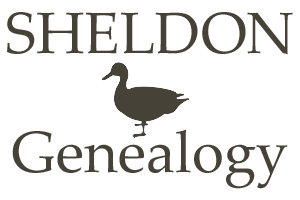

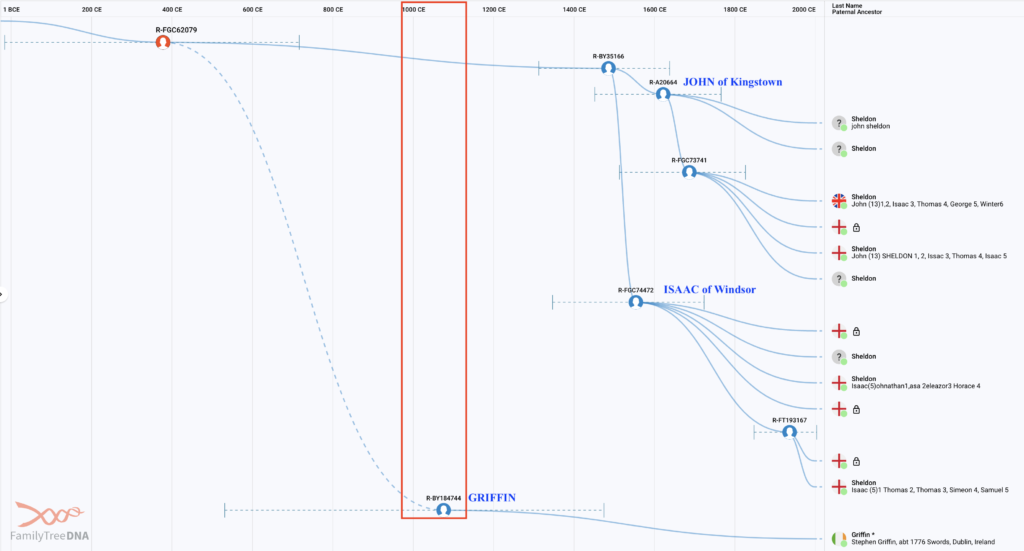
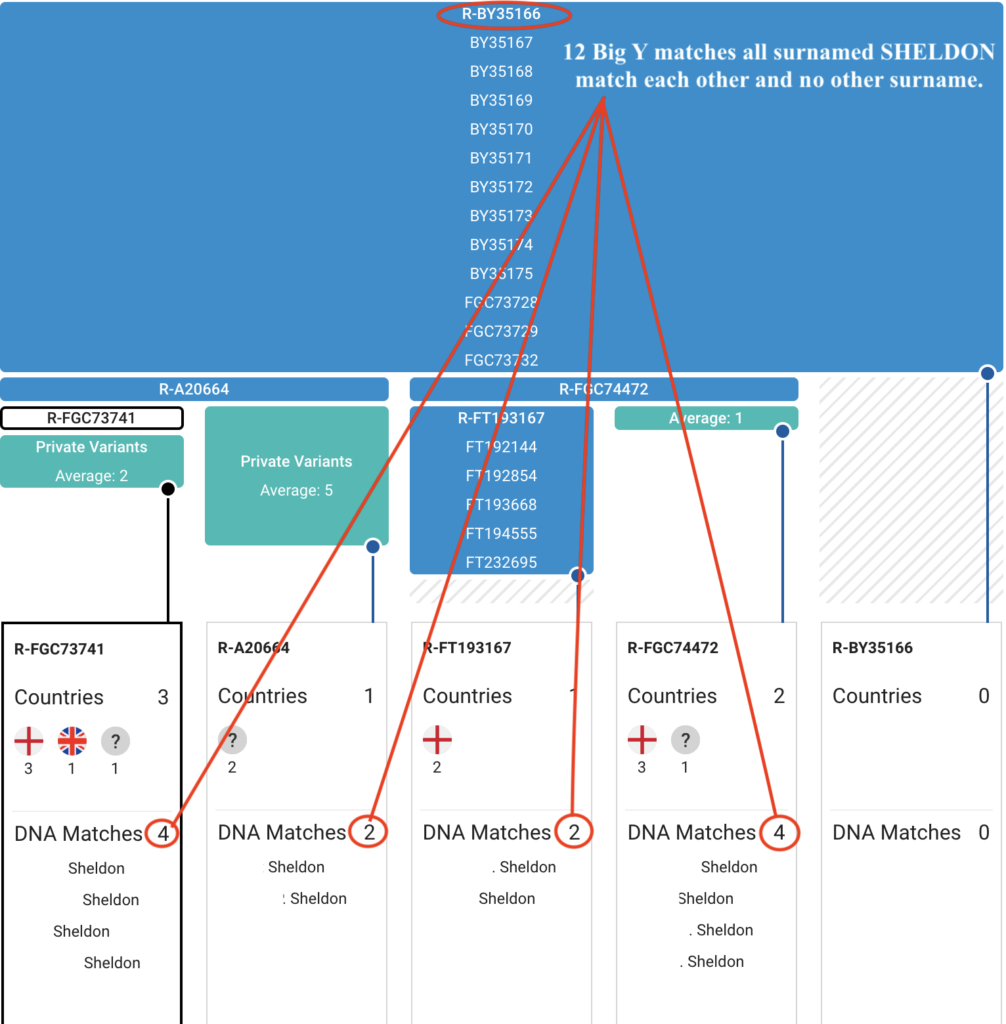
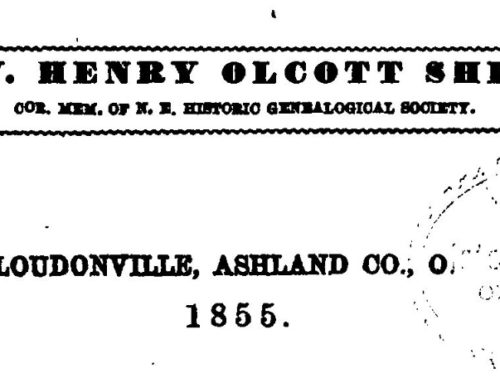
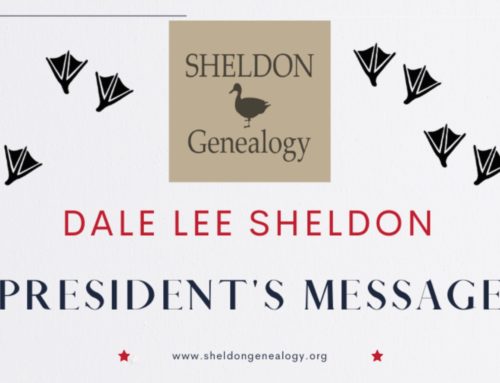
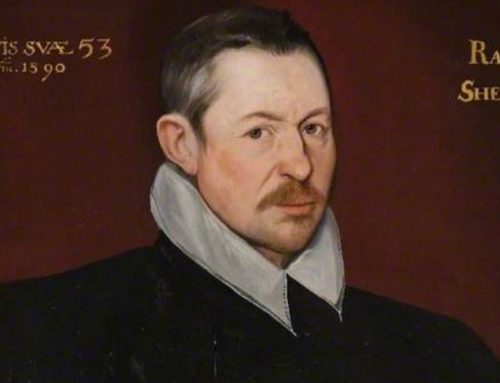
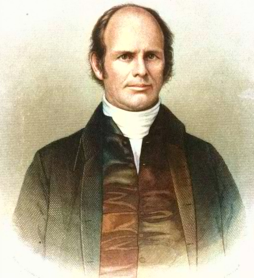

Leave A Comment
You must be logged in to post a comment.